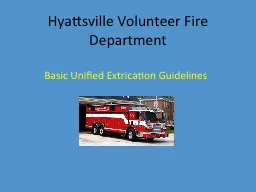

Basic Unified Extrication Guidelines Definitions Working AreaHot ZoneInner Circle 10 ft radius around vehicle ABC Posts etc Vertical structural member of the vehicle connecting the roof to the vehicles body Post designations are from the front of the vehicle to the rear sta ID: 278793
Download Presentation The PPT/PDF document "Hyattsville Volunteer Fire Department" is the property of its rightful owner. Permission is granted to download and print the materials on this web site for personal, non-commercial use only, and to display it on your personal computer provided you do not modify the materials and that you retain all copyright notices contained in the materials. By downloading content from our website, you accept the terms of this agreement.
Slide1
Hyattsville Volunteer Fire Department
Basic Unified Extrication GuidelinesSlide2
Definitions
Working Area/Hot Zone/Inner Circle- 10 ft. radius around vehicleA,B,C Posts, etc.
- Vertical structural member of the vehicle connecting the roof to the vehicle’s body. Post designations are from the front of the vehicle to the rear, starting with the two posts that are connected to the front windshield and the roof (Driver side A-Post and Passenger Side A-Post
SRS-
Supplemental or Secondary Restraint System
SIP-
Side Impact Protection
“IC”-
Impact curtain…automobile manufacturers have adopted this icon to identify hidden side-impact curtains. This icon is usually at the outer edge of the interior roof liner trim.
Pressurized Vessels-
“Piston Rods” can be a component of the vehicle’s energy absorbing bumper and/or a unit that may serve as a hinge for a trunk or hood of a vehicle.Slide3
Rescue Squad Crew
Officer - Directs ALL operations within Hot ZoneDriver - Responsible for Hot Zone logistics and all equipment to come off Rescue Squad
Senior Squadsman – Tool and Team Assignments, primary rescue toolSquadsman (1-5) – Stabilization, vehicle prep, extricationSlide4
Engine Company
Officer – Oversees squad company support functions (batteries, suppression efforts, initial patient care)Driver – Water supply, charges hoselineLine – Operates safety hoseline
Back-up – Vehicle battery, assists lineman, patient careHall/Layout – Initial patient careSlide5
BLS/PA Companies
Tech/Officer – Primary Patient Care Provider (assesses patient, makes face to face with Hot Zone Supervisor)Driver – Vehicle positioning, supports patient care3
rd – Assists techObserver – Camera…stays out of Hot Zone!Slide6
General Scene Safety
Specific Considerations to take on any motor vehicle accident include:Other motoristsHazmats
PowerlinesTreesDitches
TrenchesSlide7
Basic Vehicle Placement
Basic Fend Away Position blocking traffic from motor vehicle accident
Demonstrates location of other vehicles within incident perimeterSlide8
Resources Needed for Safe Scene
Given aforementioned considerations who or what might we need to request?Power CompanyGas Company
Heavy WreckerCraneSlide9
PPE
All members operating within Hot Zone must be in full PPE and don safety glassesSuppression crew must be prepared with SCBA as well
THIS INCLUDES EMS PERSONNEL!!!
Your turnout gear should always be with you to begin with, and definitely donned for an extricationSlide10
Incident Zones
Hot Zone – Only authorized operational personnel enter, must be in required PPE
Warm Zone – Companies serving in a support role are here.
Hoseline
, EMS (stretcher and backboard) prior to extrication completion
Cold Zone – Vehicle staging, command post, patient care areaSlide11
Scene Control
Rescue Squad OIC is responsible for extrication game planThat information needs to be conveyed to key players on scene for a smooth operationKey Players are: Command, Primary EMS Provider, Extrication Group Supervisor, Suppression Group SupervisorSlide12
Vehicle Assessment
How do we stabilize based on what we see?
Where are the patients?
What might we need here?
The Rescue Squad OIC must have a steady stream of plans. As the scene evolves a continuous size-up must happen. A new size-up may reveal a need to change the plan.Slide13
Patient Assessment
Once the scene is stabilized (including the vehicle) a patient assessment can take place.A C-Spine injury can be aggravated or worsened by slight movements in the vehicle.Suspension should be isolated before anyone enters the vehicle even to hold C-SpineSlide14
Stabilization
Patient Access should be limited until proper stabilization
Eliminate Suspension Travel
Ensures vehicle is 100% fixed in its location
Must be continuously reassessed as the vehicle is dismantled.Slide15
Patient Assessment Cont…
Done by first arriving personnel (triage all patients in vehicle)Ongoing, determine trauma status (GCS)
Identify Mechanisms and Intrusions to the vehicle.
What did the vehicle hit, drive through, and where did it come to stop?
Where are the intrusions? Passenger compartment vs. front or rear impacts?Slide16
Modern Vehicle ConcernsSlide17
Alternative Fuels
Symbols to IdentifySlide18
Completion of Extrication
Squad crew removes any unnecessary equipment from the Hot ZoneEMS is primarily responsible for actual patient removal and should determine method or removal based on how squad left vehicleAssistance with victim should be requested immediately through squad officer